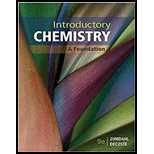
Concept explainers
Atoms form ions so as to achieve electron configurations similar to those of the noble gases. For the following pairs of noble gas configurations, give the formulas of two simple ionic compounds that would have comparable electron configurations.
msp;
(a)
Interpretation:
For the given pair of noble gas configurations, the formula of two simple ionic compounds that would have comparable electron configuration is to be stated.
Concept Introduction:
The distribution of the electrons that exists in the atomic orbital of an atom is collectively known as electron configuration. The description of every electron in an orbital is given by the electron configuration of that atom.
Atoms lose or gain electrons to become stable by attaining nearest noble gas configuration. While doing so, they are converted to their respective ions. The positive ion and the negative ion combine to form their corresponding salt.
Answer to Problem 40QAP
The ionic compounds that have comparable electron configuration to the given pair of noble gas configurations are
Explanation of Solution
The given noble gas configurations are
Ionic compound 1:
An ionic compound consists of both cations and anions.
The electron configuration of
The electron configuration of
The ionic compound that has comparable electron configuration of the given pair of noble gas configurations is
Ionic compound 2:
An ionic compound consists of both cations and anions.
The electron configuration of
The electron configuration of
The ionic compound that has comparable electron configuration to the given pair of noble gas configurations is
(b)
Interpretation:
For the given pair of noble gas configurations, the formula of two simple ionic compounds that would have comparable electron configuration is to be stated.
Concept Introduction:
The distribution of the electrons that exists in the atomic orbital of an atom is collectively known as electron configuration. The description of every electron in an orbital is given by the electron configuration of that atom.
Atoms lose or gain electrons to become stable by attaining nearest noble gas configuration. While doing so, they are converted to their respective ions. The positive ion and the negative ion combine to form their corresponding salt.
Answer to Problem 40QAP
The ionic compounds that have comparable electron configuration the given pair of noble gas configurations are
Explanation of Solution
The given noble gas configurations are
Ionic compound 1:
An ionic compound consists of both cations and anions.
The electron configuration of
Consider sodium with atomic number,
The ionic compound that has comparable electron configuration to the given pair of noble gas configurations is
Ionic compound 2:
An ionic compound consists of both cations and anions.
The electron configuration of
Consider oxygen with atomic number,
The ionic compound that has comparable electron configuration the given pair of noble gas configurations is
(c)
Interpretation:
For the given pair of noble gas configurations, the formula of two simple ionic compounds that would have comparable electron configuration is to be stated.
Concept Introduction:
The distribution of the electrons that exists in the atomic orbital of an atom is collectively known as electron configuration. The description of every electron in an orbital is given by the electron configuration of that atom.
Atoms lose or gain electrons to become stable by attaining nearest noble gas configuration. While doing so, they are converted to their respective ions. The positive ion and the negative ion combine to form their corresponding salt.
Answer to Problem 40QAP
The ionic compounds that have comparable electron configuration the given pair of noble gas configurations are
Explanation of Solution
The given noble gas configurations are
Ionic compound 1:
An ionic compound consists of both cations and anions.
The electron configuration of
The electron configuration of
So, the ionic compound that have comparable electron configuration the given pair of noble gas configurations is
Ionic compound 2:
An ionic compound consists of both cations and anions.
The electron configuration of
The electron configuration of
So, the ionic compound that have comparable electron configuration the given pair of noble gas configurations is
(d)
Interpretation:
For the given pair of noble gas configurations, the formula of two simple ionic compounds that would have comparable electron configuration is to be stated.
Concept Introduction:
The distribution of the electrons that exists in the atomic orbital of an atom is collectively known as electron configuration. The description of every electron in an orbital is given by the electron configuration of that atom.
Atoms lose or gain electrons to become stable by attaining nearest noble gas configuration. While doing so, they are converted to their respective ions. The positive ion and the negative ion combine to form their corresponding salt.
Answer to Problem 40QAP
The ionic compounds that have comparable electron configuration the given pair of noble gas configurations are
Explanation of Solution
The given noble gas configurations are
Ionic compound 1:
An ionic compound consists of both cations and anions.
The electron configuration of
The electron configuration of
The ionic compound that has comparable electron configuration to the given pair of noble gas configurations is
Ionic compound 2:
An ionic compound consists of both cations and anions.
The electron configuration of
The electron configuration of
The ionic compound that have comparable electron configuration the given pair of noble gas configurations is
Want to see more full solutions like this?
Chapter 12 Solutions
Introductory Chemistry: A Foundation
- The Lewis structures for CH4,N2,andCO2, along with the corresponding space-filling molecular images, are shown here: Use Lewis theory and VSEPR theory to draw similar space-filling molecular images of a.COb.NH3c.H2Sd.SiH4arrow_forwardWhat is meant by a chemical bond? Why do atoms form bonds with each other? Why do some elements exist as molecules in nature instead of as free atoms?arrow_forwardwhat's the difference between these two formula in structure? can you pls draw the lewis structure for both of them? and how do we know the central atom for themarrow_forward
- On the basis of the electronegativity values given in Fig. 12.3, indicate whether each of the following bonds would be expected to be ionic, covalent, or polar covalent. msp;a.HOc.HHb.OOd.HClarrow_forwardWrite Lewis structures for the following: (a) ClF3 (b) PCl5 (c) BF3 (d) PF6arrow_forwardUse the data in Figure 3.11 and Table 3.2 to calculate the energy changes (E) for the following pairs of reactions: (a) Na(g)+I(g)Na+(g)+I(g) Na(g)+I(g)Na(g)+I+(g) (b) Rb(g)+Br(g)Rb+(g)+Br(g) Rb(g)+Br(g)Rb(g)+Br+(g) Explain why Na+I and Rb+Br form in preference to NaI+ and RbBr+ .arrow_forward
- Consider the molecular structures illustrated in the previous exercise. For each structure, give an example compound that has that arrangement of atoms.arrow_forwardFor each of the following numbers of electrons, give the formula of a positive ion that would have that number of electros, and write the complete electros configuration for each ion. msp;a.10electronsc.18electronsb.2electronsd.36electronsarrow_forward
 Introductory Chemistry: A FoundationChemistryISBN:9781337399425Author:Steven S. Zumdahl, Donald J. DeCostePublisher:Cengage Learning
Introductory Chemistry: A FoundationChemistryISBN:9781337399425Author:Steven S. Zumdahl, Donald J. DeCostePublisher:Cengage Learning World of Chemistry, 3rd editionChemistryISBN:9781133109655Author:Steven S. Zumdahl, Susan L. Zumdahl, Donald J. DeCostePublisher:Brooks / Cole / Cengage Learning
World of Chemistry, 3rd editionChemistryISBN:9781133109655Author:Steven S. Zumdahl, Susan L. Zumdahl, Donald J. DeCostePublisher:Brooks / Cole / Cengage Learning ChemistryChemistryISBN:9781305957404Author:Steven S. Zumdahl, Susan A. Zumdahl, Donald J. DeCostePublisher:Cengage Learning
ChemistryChemistryISBN:9781305957404Author:Steven S. Zumdahl, Susan A. Zumdahl, Donald J. DeCostePublisher:Cengage Learning Chemistry for Engineering StudentsChemistryISBN:9781337398909Author:Lawrence S. Brown, Tom HolmePublisher:Cengage Learning
Chemistry for Engineering StudentsChemistryISBN:9781337398909Author:Lawrence S. Brown, Tom HolmePublisher:Cengage Learning Principles of Modern ChemistryChemistryISBN:9781305079113Author:David W. Oxtoby, H. Pat Gillis, Laurie J. ButlerPublisher:Cengage Learning
Principles of Modern ChemistryChemistryISBN:9781305079113Author:David W. Oxtoby, H. Pat Gillis, Laurie J. ButlerPublisher:Cengage Learning Introductory Chemistry: An Active Learning Approa...ChemistryISBN:9781305079250Author:Mark S. Cracolice, Ed PetersPublisher:Cengage Learning
Introductory Chemistry: An Active Learning Approa...ChemistryISBN:9781305079250Author:Mark S. Cracolice, Ed PetersPublisher:Cengage Learning





